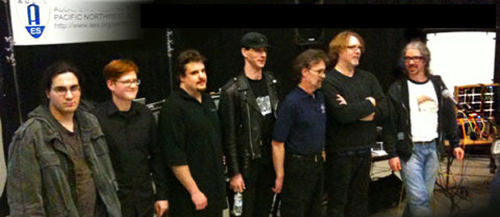Electronic Music Modular

Pacific Northwest AES Meet
By Steve Turnidge
On February 17th, 2010, some of the rising stars of the modular synthesizer scene gave demonstrations of some innovative new products as well as showing off some of the more tried and trusted, but never completely predictable, modular delights at the February meet of the Pacific Northwest section of the AES.
This was a great opportunity to play catch-up for those new to the world of modular synthesizers - a world of infinitely variable possibilities that started in the early 70s when modular synthesis was pretty much the only way to go. If you're old enough, think back to the Buchla, Moog 900-series, and the ARP 2600 synthesizers. If not...
In the beginning, there were several separate modules, each responsible for a specific aspect of sound creation: Voltage Controlled Oscillators (VCOs), Voltage Controlled Filters (VCFs) and Voltage Controlled Amplifiers (VCAs). It wasn't too long afterwards that Low Frequency Oscillators (LFOs), Sequencers/Arpeggiators, and Envelope Generators joined the party, creating a broad range of wonderful synthesized sounds. The flexibility of such a system was tremendous - primarily because the modules were connected together by patch cords, encouraging sound exploration and design. That flexibility came at a cost - complexity and price. The modular synths of the day were well out of range of all but the most serious musicians and academia. In addition, the different manufacturers had proprietary sizes and interfaces for their equipment.
This complexity led to an integration of functionality - the standard modules and patches that create sounds were put together and pre-patched, with control mainly of the parameters of the components, but not their order/configuration... These units incrementally came down in price until the pendulum swung furthest in the mid to late 80s. Here we had synthesizers whose human interface consisted of a couple of 7 segment LEDs and a data slider. The majority of the "patches" (named for the earlier use of patch cables to build a sound) were pre-set and canned. Much of the joy the synthesist derived from creating and manipulating their own sounds in real time evaporated. On the other hand, for live performance, a synthesizer with presets was really the only practical solution, because there was no way for a modular synthesizer to change patches quickly during performance.
Fortunately, with the lead of several visionaries in the field, modular synthesis has been revived and the costs have dropped enough to become accessible to the general audience. There are new modular standards that provide opportunities for many manufacturers to make modules that interoperate seamlessly and inexpensively. On February 17th we were there to meet several of those manufacturers.
Confirmed guests included:
George Mattson, Mattson Modular - Interview
James Husted, Synthwerks www.synthwerks.com - Interview
Scott Jaeger, The Harvestman - Interview
~flight, Flight Of Harmony - Interview
Scott Rise, Division 6 - Interview
Stephen Jones - Video
© electronicmusic.com